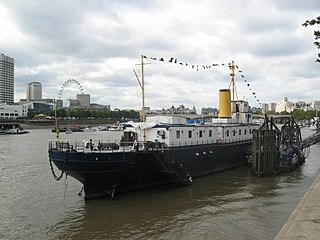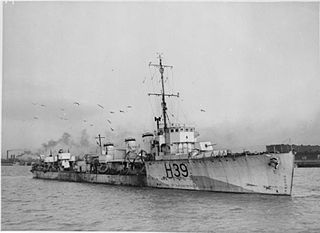Two ships of the Royal Navy have been named HMS Polyanthus after the flower:
- HMS Polyanthus (1917) was an Aubrietia-class sloop of World War I
- HMS Polyanthus (K47) was a Flower-class corvette of World War II
Two ships of the Royal Navy have been named HMS Polyanthus after the flower:
Several ships of the Royal Navy have been named HMS Hyacinth after the hyacinth flower:

The Flower-class corvette was a British class of 294 corvettes used during World War II, specifically with the Allied navies as anti-submarine convoy escorts during the Battle of the Atlantic. Royal Navy ships of this class were named after flowers, hence the name of the class.
HMS Zinnia may refer to the following ships of the Royal Navy:
HMS Camellia may refer to one of two ships of the Royal Navy named after Camellia, the genus of flowering plants:
HMS Itchen may refer to one of the following British Royal Navy ships named after the English River Itchen:
Two ships of the Royal Navy have been named HMS Bergamot after the bergamot flower.
Several Canadian naval units have been named HMCS Ville de Quebec.

HMS President (1918) is a retired Flower-class Q-ship that was launched in 1918. She was renamed HMS President in 1922 and moored permanently on the Thames as a Royal Navy Reserve drill ship. In 1982 she was sold to private owners and, having changed hands twice, served as a venue for conferences and functions as well as the offices for a number of media companies. She has been moved to Chatham on the Medway in Kent since 2016, but is due to return to the capital. She had the suffix "(1918)" added to her name in order to distinguish her from HMS President, the Royal Naval Reserve base in St Katharine Docks. She is one of the last three surviving Royal Navy warships of the First World War. She is also the sole representative of the first type of purpose built anti-submarine vessels, and is the ancestor of World War II convoy escort sloops, which evolved into modern anti-submarine frigates.

The Aubrietia-class sloops were a class of twelve sloops built under the Emergency War Programme for the Royal Navy in World War I as part of the larger Flower class. They were also referred to as the "cabbage class", or "herbaceous borders". The Flowers were the first ships designed as minesweepers.

Henry Robb, Limited, known colloquially as Robbs, was a Scottish shipbuilding company based at Leith Docks in Edinburgh. Robbs was notable for building small-to-medium sized vessels, particularly tugs and dredgers.
Halifax commonly refers to:
Three Royal Navy ships have been names HMS Snapdragon, after the flower:

An Escort Group consisted of several small warships organized and trained to operate together protecting trade convoys. Escort groups were a World War II tactical innovation in anti-submarine warfare by the Royal Navy to combat the threat of the Kriegsmarine's "wolfpack" tactics. Early escort groups often contained destroyers, sloops, naval trawlers and, later, corvettes of differing specifications lacking the ability to maneuver together as a flotilla of similar warships, but rigorously trained in anti-submarine tactics to use teamwork emphasizing the unique sensors, weapons, speed, and turning radius of each ship. The development of these 'escort groups' proved an effective means of defending shipping convoys through the Battle of the Atlantic.
Three ships of the Royal Navy have been named HMS Arbutus:
HMS Polyanthus was a Flower-class corvette of the Royal Navy. She was launched on 30 November 1940 from Leith Docks on the Firth of Forth, at an estimated cost of £55,000. Polyanthus was sunk by the German submarine U-952 using new German weapons technology on 20 September 1943 about 1,000 miles southwest of Reykjavík during convoy escort duty in the Battle of the North Atlantic.
There have been at least two ships of the Royal Navy named HMS Privet:
K47 may refer to:
Three ships of the Royal Navy have borne the name HMS Coreopsis, named after the flowering plant coreopsis.
HMS Itchen (K227) was a River-class frigate of the Royal Navy (RN). Itchen was built to the RN's specifications as a Group I River-class frigate. She served in the North Atlantic during World War II.